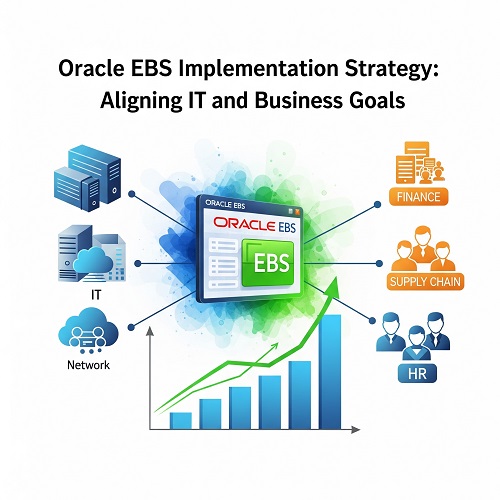Oracle EBS Implementation Strategy: Aligning IT and Business Goals
When business operations outgrow fragmented systems and legacy processes, it’s time to implement an integrated solution that brings IT and business goals into perfect sync. Oracle EBS implementation offers exactly that—a scalable, unified suite capable of streamlining complex workflows and driving enterprise-wide efficiency. But implementation success doesn’t come from software alone—it comes from strategy.
Technology can only take an enterprise so far. The real differentiator lies in how that technology is adopted, adapted, and aligned with your business roadmap. Strategic Oracle EBS implementation creates harmony between your business goals and IT architecture, creating a single source of truth that enables proactive decision-making, operational resilience, and long-term agility.
Aligning the technical and operational aspects of your business requires more than a checklist. It takes foresight, collaboration, expert guidance, and the right Oracle support partner. In this blog, we break down the critical components of a successful Oracle EBS implementation strategy that helps align IT frameworks with business goals, ensuring real results. Whether you’re upgrading from legacy ERP or launching your first enterprise-wide system, the path to success is paved with the right strategy.
Understanding Oracle EBS: More Than Just Software
Oracle E-Business Suite (EBS) is a comprehensive set of business applications designed to automate and manage enterprise processes. These modules span across:
- Finance and accounting
- Supply chain management
- Human resources
- Procurement
- Manufacturing
- Customer relationship management
As a unified platform, Oracle EBS simplifies interdepartmental collaboration, enhances data visibility, and provides scalability for growing enterprises. It integrates diverse functions into one ecosystem, allowing departments to work from a shared database and reducing duplication, errors, and bottlenecks.
Oracle EBS implementation is not simply a tech deployment. It’s a strategic move that impacts core business operations. When implemented right, it unifies processes, improves reporting accuracy, enhances compliance, and supports scalability. Organizations can create a performance-driven environment that adapts quickly to market needs, customer expectations, and internal objectives.
Why Does IT-Business Alignment Matters?
A disconnected approach—where IT teams and business leaders function in silos—can derail even the most robust ERP systems. When properly aligned, IT infrastructure serves business strategy rather than hindering it. Here’s why it matters:
- Improved Decision-Making: Real-time data sharing supports faster and better business decisions.
- Increased Efficiency: Streamlined operations and reduced redundancies.
- Agility and Innovation: Adapt quickly to market or regulatory changes.
- Value Realization: Maximizing the ROI of your Oracle EBS investment.
- Cross-Functional Collaboration: Teams work more effectively when using the same data systems and dashboards.
- Risk Reduction: A unified system offers better visibility into compliance, audits, and risk mitigation.
When IT and business goals are in sync, companies can leverage Oracle EBS not just as a software platform but as a business enabler—with the strategic guidance of Oracle consulting companies to maximize its impact.
Key Challenges in Oracle EBS Implementation
Even with robust capabilities, implementation comes with its set of hurdles:
- Resistance to Change: Stakeholder buy-in is often missing.
- Misaligned Objectives: IT executes one plan while business expects another.
- Data Migration Complexities: Transitioning from legacy systems can be tricky.
- Customization Overload: Excessive tailoring can cause long-term issues.
- Lack of Skilled Resources: Oracle EBS expertise isn’t always available in-house.
- Budget and Timeline Overruns: Scope creep and unforeseen complexities often delay go-live dates.
Identifying these roadblocks early ensures your strategy proactively addresses them. Anticipating challenges helps to align team expectations, allocate budgets wisely, and avoid post-go-live disruptions.
Crafting a Strategic Oracle EBS Implementation Plan
1. Start with Business Goals
Before diving into tech requirements, understand the “why” behind the implementation:
- What are the pain points?
- What business KPIs are you trying to improve?
- How will Oracle EBS drive long-term value?
This clarity forms the foundation for a targeted implementation that supports measurable outcomes. Business-driven goals ensure that the platform does not just serve IT objectives but contributes directly to ROI, efficiency, and growth.
2. Engage Stakeholders Across Departments
Cross-functional teams bring diverse insights and help bridge the gap between technical and business goals. Include representatives from:
- Finance
- Operations
- HR
- IT
- Customer Service
This early involvement fosters ownership, reduces resistance, and ensures smoother adoption. Everyone must be part of the transformation journey.
3. Select the Right Oracle Consulting Company
Choosing a trusted Oracle EBS support company ensures guidance across planning, configuration, training, and post-go-live support. You need a partner that understands both business processes and technical intricacies.
SoftArt is one such expert-led provider known for delivering customized Oracle solutions aligned with enterprise objectives.
4. Create a Phased Rollout Strategy
Avoid big-bang deployments. A phased approach allows better change management, testing, and adjustments.
- Phase 1: Core modules (Finance, HR)
- Phase 2: Supply Chain and Procurement
- Phase 3: Manufacturing, CRM
Each phase should be reviewed and optimized before moving forward. This reduces downtime and maximizes resource availability.
5. Focus on Change Management and Training
Implementation isn’t just about the software—it’s about people. Proactive training programs, internal champions, and continuous feedback loops are key to adoption.
- Tailored training per department
- Hands-on sessions
- Role-based dashboards and workflows
6. Data Migration and Integration Planning
Clean, structured, and validated data sets the foundation for Oracle EBS success. Also, integrate with:
- Legacy systems (if needed)
- Third-party tools
- BI dashboards
Inaccurate data can lead to flawed analytics and poor business decisions. Spend time on data cleansing and validation.
Best Practices for Seamless Implementation
- Define Clear Success Metrics: Tie outcomes to business KPIs (cost savings, faster reporting, reduced errors).
- Minimize Customization: Stick to Oracle’s standard features unless absolutely necessary.
- Invest in User Experience: A clunky interface reduces adoption—prioritize usability.
- Optimize Post-Go-Live Support: Partner with a reliable Oracle EBS support company for performance tuning, issue resolution, and upgrades.
- Conduct Regular Audits: Post-implementation health checks are essential.
- Embrace Agile Methodologies: Short sprints and feedback cycles allow iterative improvement.
- Use Sandbox Environments: Test configurations and scenarios before deploying in production.
Measuring Success: Aligning IT with Business KPIs
To truly validate alignment, your strategy should translate into measurable business benefits:
| Goal | KPI | Oracle EBS Impact |
| Reduce Operating Costs | Lower IT overhead | Automation and centralized processes |
| Improve Compliance | Audit readiness | Standardized, traceable workflows |
| Increase Revenue | Faster order-to-cash | Streamlined sales & distribution |
| Employee Productivity | Faster task turnaround | Intuitive dashboards & workflows |
| Customer Satisfaction | On-time delivery | Optimized supply chain visibility |
Common Pitfalls to Avoid
- Skipping discovery workshops
- Underestimating training needs
- Lack of executive sponsorship
- Ignoring ongoing support planning
- Overlooking post-launch analytics and adjustments
- Overreliance on legacy workflows that no longer serve current needs
Avoiding these can drastically improve implementation outcomes.
Realigning During and After Implementation
Alignment is not a one-time activity. As your business evolves, so should your Oracle EBS framework. Schedule periodic reviews to:
- Revisit goals and configurations
- Analyze module usage and adoption
- Scale to new business areas or geographies
- Introduce automation features and new Oracle updates
SoftArt helps businesses continuously fine-tune their Oracle environments, ensuring the software grows in tandem with your organization’s needs. They bring a strategic lens to technical upgrades, ensuring your Oracle EBS instance stays future-ready.
Conclusion: Building a Future-Proof Oracle EBS Strategy
An effective Oracle EBS implementation strategy doesn’t just deploy software—it embeds agility, transparency, and data intelligence across your enterprise. By aligning your IT architecture with broader business goals, you unlock the full potential of Oracle EBS to drive long-term value.
The true measure of success lies in how seamlessly Oracle EBS empowers people, improves processes, and enhances performance. With the right plan, the right support partner, and continuous evolution, your EBS journey becomes a strategic advantage, not just a system implementation.
Whether you’re planning your first rollout or optimizing an existing instance, remember: strategy is the difference between a functional ERP and a transformational one.
To set your business up for success, partner with experts who don’t just understand Oracle—but also understand your vision.
Read More – How to Implement and Integrate NetSuite for Business Efficiency?













